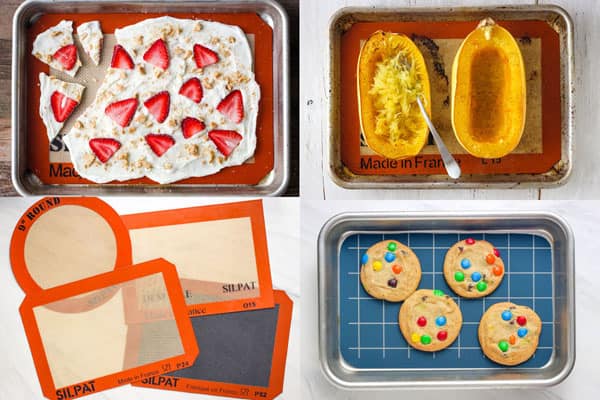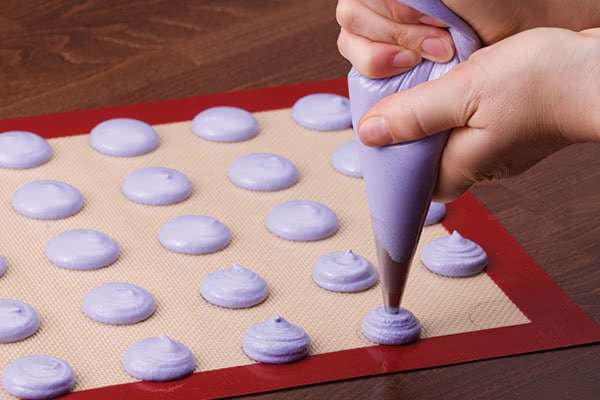Yes, you can put silicone baking mats directly in the oven. They are designed to withstand high temperatures, typically up to 480°F (250°C).
They provide a non-stick surface for baking without needing parchment paper or cooking spray.
However, avoid placing them directly on the oven’s heating elements or open flames, and always check the manufacturer’s temperature guidelines for safety.

Introduction To Silicone Baking Mats
Silicone baking mats have become a popular tool in many kitchens. These mats offer a non-stick surface for baking. They are reusable and easy to clean. But can you put silicone baking mats directly in the oven? Before diving into that, let’s explore what these mats are and their common uses.
What Are Silicone Baking Mats?
Silicone baking mats are made from food-grade silicone. They provide a non-stick surface for baking. This means less oil and parchment paper. These mats can withstand high temperatures. They are often used in place of parchment paper or foil. Silicone mats come in various sizes and shapes. Some even have measurements printed on them for easier baking.
Common Uses
Silicone baking mats have many uses in the kitchen. They are perfect for baking cookies and pastries. You can also use them for roasting vegetables. They provide an even baking surface. This helps food cook more evenly. Silicone mats are great for rolling out dough. The non-stick surface makes it easy to handle sticky dough. They are also useful for kneading bread. Their versatility makes them a must-have kitchen tool.
Heat Resistance Of Silicone Mats
Silicone baking mats are popular in many kitchens. They offer a non-stick surface and are easy to clean. But how do they handle high temperatures? Let’s explore the heat resistance of silicone mats.
Temperature Limits
Silicone mats can withstand high temperatures. Most mats can handle up to 450°F (232°C). Some high-quality mats can even go up to 500°F (260°C). Always check the manufacturer’s guidelines for exact limits. This ensures safe use without damaging the mat.
Safety Tips
Use silicone mats within recommended temperature limits. This prevents any risks. Avoid placing mats directly on open flames. Also, do not use them under broilers. Regularly inspect mats for wear and tear. Replace them if you see cracks or discoloration. This helps maintain safety and performance.
Benefits Of Using Silicone Mats
Silicone baking mats can go directly in the oven. They provide even heat distribution and are non-stick, making cleanup easy. These mats are durable and reusable, saving money and reducing waste.
Silicone baking mats have become popular in many kitchens. They offer several benefits that make baking easier and more enjoyable. These mats are made from food-grade silicone, making them safe for oven use.
Non-stick Surface
Silicone mats have a non-stick surface. This means food does not stick to them. You can bake cookies, pastries, and other treats without using oils or sprays. The non-stick feature ensures your baked goods come out perfectly every time.
Easy Cleanup
Cleaning up after baking can be a hassle. Silicone mats make this task simple. They do not require scrubbing or soaking. You can wash them with warm soapy water. Many silicone mats are also dishwasher safe. This saves you time and effort in the kitchen.

Credit: toasterovenlove.com
How To Use Silicone Mats In The Oven?
Silicone baking mats can go directly into the oven. They are great for even heating and non-stick surfaces. Just place the mat on a baking sheet before use.
Silicone baking mats are a versatile addition to any kitchen. They offer a non-stick surface that makes baking easier. Whether you’re making cookies or roasting vegetables, these mats can help. But how do you use them in the oven?
Preparation Steps
First, ensure your silicone mat is clean. Wash it with warm, soapy water. Rinse and let it dry completely. Place the silicone mat on a baking sheet. This supports the mat and makes it easier to handle.
Next, preheat your oven to the required temperature. Silicone mats can withstand high heat, usually up to 480°F (250°C). Check the manufacturer’s instructions for the maximum temperature.
Baking Tips
Place your food directly on the silicone mat. It will not stick, so no need for extra oil or parchment paper. Spread the food evenly for consistent baking.
Monitor the baking time. Silicone mats can sometimes cause food to cook faster. Check your food a few minutes earlier than the recipe suggests.
After baking, remove the silicone mat from the oven. Let it cool before washing. Silicone mats are dishwasher safe, but hand washing extends their lifespan.
Store your silicone mat flat or rolled up. Avoid folding it to prevent creases.
With these simple steps, you can use silicone mats effectively. Happy baking!
Comparing Silicone Mats To Other Baking Tools
Silicone baking mats can go directly in the oven. They offer a non-stick surface, unlike parchment paper or aluminum foil. These mats withstand high temperatures without burning.
When it comes to baking, there are many tools you can use. Two of the most common are silicone baking mats and other traditional baking tools. But how do they stack up against each other? Let’s break it down.
Silicone Vs. Parchment Paper
Parchment paper has been a kitchen staple for years. It’s handy, disposable, and gets the job done. But silicone baking mats? They bring something new to the table.
Benefits of Silicone Mats:
– Reusable: Unlike parchment paper, you can use silicone mats over and over again. This means less waste and fewer trips to the store.
– Non-stick Surface: Silicone mats are naturally non-stick. No need for extra grease or sprays. Your cookies will slide right off.
– Even Heat Distribution: Silicone mats distribute heat evenly. This helps prevent hot spots and ensures your baked goods come out perfect every time.
On the other hand, parchment paper is great because:
– Disposable: No cleanup required. Just toss it after use.
– Versatile: You can cut it to fit any pan size or shape.
– Heat Resistant: Parchment paper can handle high temperatures without burning.
So, if you want a fuss-free option, go for parchment paper. But if you’re looking for a long-term, eco-friendly choice, silicone mats are the way to go.
Silicone Vs. Metal Trays
Metal trays are another popular baking tool. They’re sturdy, and they heat up quickly. But how do they compare to silicone mats?
Advantages of Silicone Mats:
– Flexible: Silicone mats are bendable. You can roll them up for easy storage.
– Non-stick: Just like with parchment paper, nothing sticks to a silicone mat. Say goodbye to scrubbing burnt bits off your metal trays.
– Temperature Safe: Silicone mats can handle both high and low temperatures. You can use them in the oven, microwave, or even the freezer.
Metal trays have their own perks too:
– Durable: Metal trays can take a beating. They won’t tear or wear out easily.
– Crispy Results: Metal trays help get that perfect crispy edge on your cookies or pizza.
– Direct Heat: They heat up fast, which can be great for certain recipes.
If you love crispy edges and don’t mind a bit of scrubbing, metal trays are excellent. But if you value flexibility and ease of use, silicone mats win hands down.
In conclusion, both silicone mats and traditional baking tools have their pros and cons. It all depends on what you value most in your baking process. Whether it’s the convenience of parchment paper, the durability of metal trays, or the eco-friendliness of silicone mats, there’s a tool out there for every baker. So go ahead, try them out, and find what works best for you!
Care And Maintenance
Proper care and maintenance of silicone baking mats ensure their longevity. These mats are durable, but they require some attention. Follow these simple steps to keep them in good condition.
Cleaning Methods
Always clean silicone baking mats after each use. Use warm water and mild dish soap. Avoid using abrasive sponges. They can damage the mat’s surface. A soft cloth works best.
For stubborn stains, soak the mat in hot water. Add a bit of baking soda. Scrub gently with a soft brush. Rinse thoroughly. Dry with a clean towel.
Storage Tips
Store silicone baking mats flat. This prevents creases and folds. Place them in a drawer or cupboard. Avoid stacking heavy items on top.
You can also store mats rolled up. Use a rubber band to keep them secure. Store in a dry, cool place. Keep away from direct sunlight. This helps maintain their flexibility.
Potential Drawbacks
Hey friends, today we’re diving into the potential drawbacks of using silicone baking mats directly in the oven. While these mats can be super handy, they aren’t without their downsides. Let’s explore a couple of key concerns.
Durability Concerns
First up, let’s talk about durability. Silicone baking mats are flexible and non-stick, which is great. But, they can wear out faster than you might think. I recently had a mat that started to lose its non-stick coating after just a few months of regular use.
Here are some things to watch out for:
- Tears and Punctures: Sharp objects like knives or even tough dough can cause tears.
- Heat Damage: Prolonged exposure to high heat can make them brittle.
- Fading: Over time, the vibrant color of your mat might fade, making it look worn out.
So, always handle with care and avoid extreme heat to keep your mats in good shape.
Possible Staining
Another common issue? Staining. Yes, these mats can get stained, especially if you cook with colorful spices or certain foods. I remember baking some turmeric-infused cookies, and my mat ended up with a yellowish tint that wouldn’t go away.
Here’s what you need to know:
- Spices: Ingredients like turmeric, paprika, and curry can leave lasting stains.
- Oily Foods: Greasy foods might leave a residue that’s tough to clean.
- High-Temperature Cooking: High heat can sometimes cause discoloration.
To minimize staining, try to avoid cooking overly greasy or highly pigmented foods on your silicone mats. And if you do get a stain, clean it as soon as possible to prevent it from setting in.
So there you have it! While silicone baking mats are incredibly useful, being aware of these potential drawbacks can help you get the most out of them. Happy baking!

Credit: www.webstaurantstore.com
Frequently Asked Questions
Can You Put Silicone Baking Mats Directly On Oven Rack?
No, place silicone baking mats on a baking sheet. Direct contact with oven racks can damage the mats.
Can You Put Silicone Baking Molds Directly In The Oven?
Yes, you can put silicone baking molds directly in the oven. They are oven-safe and can withstand high temperatures. Always check the manufacturer’s guidelines for temperature limits.
Can You Cook Directly On a Silicone Mat?
Yes, you can cook directly on a silicone mat. It is non-stick, heat-resistant, and safe for baking.
How Do You Use A Silicone Baking Mat In The Oven?
Place the silicone baking mat on a baking sheet. Arrange your food or dough on the mat. Bake as directed. Ensure the mat doesn’t touch the oven walls. Clean the mat after use with warm, soapy water.
Conclusion
Silicone baking mats are safe for oven use. They withstand high temperatures. They replace parchment paper and aluminum foil. Cleanup becomes easier with silicone mats. They are durable and reusable. Baking enthusiasts find them convenient. Your baked goods won’t stick.
Silicone mats can enhance your baking experience. Try one in your next recipe. Enjoy hassle-free baking with silicone mats!
